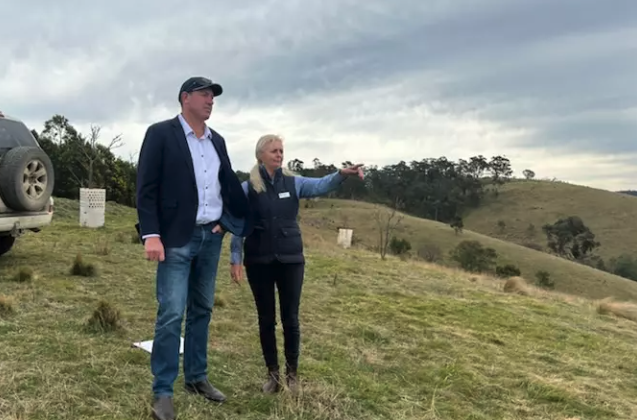Michael Kemp, NSW Member for Oxley and Mulloon’s CEO Carolyn Hall looking over the Mulloon floodplain at Duralla earlier this month.
Nats MP calls for reform to encourage natural infrastructure investment
By Andrew Norris, Editor at The Land.
Published September 27 2024.
Link to online article.
NSW’s Member for Oxley, Michael Kemp, is calling on the government to make investments into “natural infrastructure” for the future of regional landscapes.
He said the issue wasn’t necessarily a lack of funds, “it’s the red tape that’s the problem”.
In 2022, when his father’s farm near Kempsey was hit by floods, riparian areas on the property were significantly damaged and left exposed to future flood events.
However, he said the run-around through at least six departments, including Crown Lands, Local Land Services, the NSW Department of Primary industries – Fisheries, the NSW Department of Climate Change, Energy, the Environment and Water, the Natural Resource Access Regulator and local council, plus an estimated cost of $20,000 to $30,000 just to get it to the approval stage, meant it was all too hard.
“What it has done is opened my eyes to the amount of red tape for an approval,” Mr Kemp said.
“It needs to be easy for people to use – we need to be encouraging them, not blocking them.”
He said what was needed was a set of simple rules landholders could follow to self assess whether they could proceed with certain projects that were potentially beneficial for the environment and production.
Instead, he said with “all the interdepartmental ping pong, the riparian areas are not getting repaired”.
Earlier this month, he visited the Mulloon Institute at Bungendore, a not-for-profit, research, education and advocacy organisation established in 2011 which demonstrates sustainable agriculture and environmental regeneration.
Mr Kemp said the organisation’s theories, originally developed by Peter Andrews on his then property, Tarwyn Park, Bylong, around rehydrating the landscape, made significant sense for improving microclimates.
He said the Mulloon Institute had also already developed a code which could serve the purpose of simplifying project assessment and approvals, if it, or something similar, was adopted by regulators.
The challenge, according to Mulloon’s CEO Carolyn Hall, was this would require “extreme consultation with the current agencies involved to build their understanding and their confidence in the data coming out of Mulloon to then move along the path of a code-based approach”.
She said the code was based on the idea of all parties agreeing on a suite of standards that would bring agreed outcomes around functioning landscapes, biodiversity and First Nations communities.
“We’re not advocating ‘no regulation’, we’re advocating for an approach that is suitable for landscape regulation and rehydration,” she said.
Ms Hall said the regulators were challenged on this, which highlighted the need for reform.
Mr Kemp was presently gathering community support and had also discussed the matter with Nationals leader Dugald Saunders.
He aimed to create a Bill with which he would also approach Minister for the Environment Penny Sharpe.
He said the Mulloon Institute had already done a lot of the work, but the most important part was getting an environmental code with which people could comply.
“This is an opportunity to do something about it, so I’m going to make the most of it,” Mr Kemp said.
It would be no easy road, though.
As Ms Hall said, it had been a battle getting politicians interested in the work at the institute.
“We’ve had more luck with political advisors than with politicians in recent years,” she said.
“We’ve found it difficult to get the current governments – state or federal – to Mulloon, but the federal advisors have been and they acknowledge the value of the work.”
She said while the institute was grateful for the attention, there remained a need for regulatory reform to make the works easier to deliver.
Mr Kemp saw the potential for investing in “natural infrastructure” as equivalent in importance to traditional infrastructure like roads and railways.
“The Mulloon Rehydration Initiative has a planning model that can be scaled up or down to rehydrate Australia,” he said.
Mr Kemp said this was also a method through which communities and the environment could be protected from natural disasters.
“It’s time we rebuild our water catchments and landscapes to withstand these challenges,” he said.
